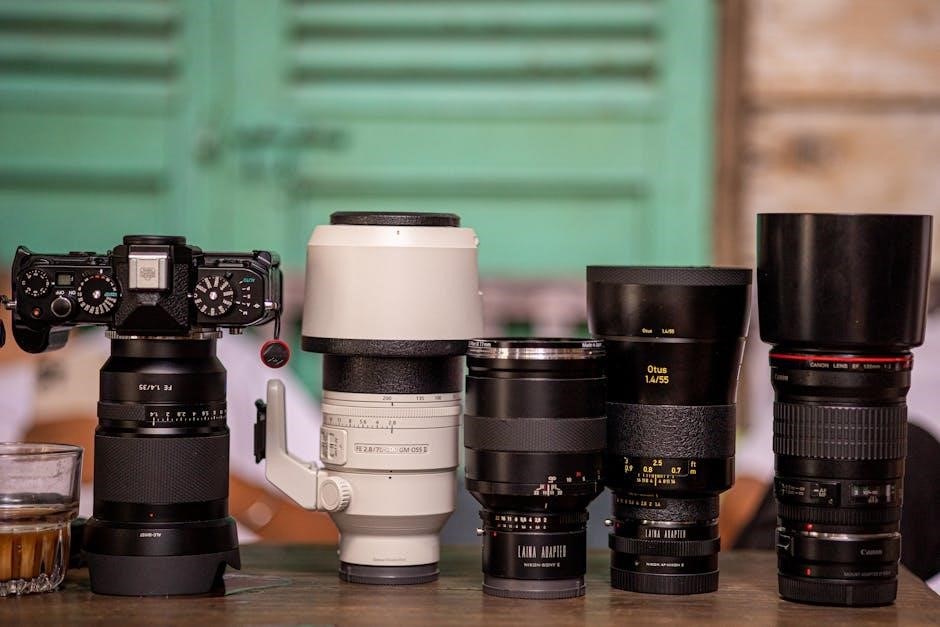ISO/IEC 17025:2017 is the global standard for laboratory accreditation, ensuring competence in testing and calibration. It provides a framework for consistent, valid results and enhanced credibility.
Overview of the Standard
ISO/IEC 17025:2017 is a global standard outlining requirements for laboratory competence in testing and calibration. It combines technical and management system elements, ensuring reliable results. The standard is structured into clauses and annexes, emphasizing risk-based thinking to reduce prescriptive requirements. It applies to all laboratories, regardless of size or industry, and is the basis for accreditation, fostering international recognition and trust in laboratory activities. Its implementation ensures consistent, valid results, enhancing credibility and operational efficiency across sectors like testing, calibration, and beyond.
Importance of Laboratory Accreditation
Laboratory accreditation to ISO/IEC 17025:2017 is crucial for ensuring the credibility and reliability of test and calibration results. It demonstrates a laboratory’s competence in delivering accurate and consistent data, fostering trust among customers and stakeholders. Accreditation enhances laboratory reputation, enabling participation in global trade and meeting regulatory requirements. It also promotes operational efficiency and continuous improvement, ensuring laboratories meet international standards. This recognition is vital across industries, from healthcare to environmental testing, reinforcing the integrity of scientific and technical activities worldwide.

History and Evolution of ISO/IEC 17025
ISO/IEC 17025:2017 was developed over five years, published in 1999, and updated in 2017 to enhance compatibility with other standards, ensuring laboratory competence and consistency.
Development Process of ISO/IEC 17025:1999
The development of ISO/IEC 17025:1999 spanned five years, starting with initial drafts in 1994. The Draft International Standard (DIS) was issued in 1998, followed by the Final Draft International Standard (FDIS) in 1999. The standard was published later that year, establishing requirements for laboratory competence. It incorporated feedback from laboratories, accreditation bodies, and industry experts. The process ensured the standard addressed both technical and management aspects, providing a robust framework for consistent and reliable test results. This version laid the groundwork for future updates, enhancing global laboratory credibility.
Revisions and Updates Leading to ISO/IEC 17025:2017
The 2017 revision of ISO/IEC 17025 aimed to modernize the standard, introducing risk-based thinking and aligning it with ISO 9001:2015. It reduced prescriptive requirements, focusing on performance-based outcomes. Key updates included enhanced clauses on impartiality, confidentiality, and management system requirements. The revision also clarified terminology and streamlined processes for better laboratory efficiency. These changes ensured the standard remained relevant to evolving industry needs, improving laboratory operations and customer trust. The updated version reflects a shift toward flexibility and adaptability in laboratory accreditation.
Key Changes Between ISO/IEC 17025:2005 and 2017 Versions
The 2017 version introduced risk-based thinking, reducing prescriptive requirements in favor of performance-based outcomes. It aligned with ISO 9001:2015, enhancing management system integration. New clauses on impartiality, confidentiality, and laboratory information management were added. Terminology was clarified, and the scope now explicitly includes all laboratory activities. The updated standard emphasizes flexibility, allowing laboratories to implement more tailored systems. These changes improved efficiency, reduced redundancy, and better aligned the standard with modern laboratory practices, ensuring global consistency and trust in testing and calibration results.

Structure of ISO/IEC 17025:2017
ISO/IEC 17025:2017 is divided into five clauses, two annexes, and a bibliography, covering scope, normative references, terms, general requirements, and structural and process demands for laboratories.
Clause 1: Scope
Clause 1 of ISO/IEC 17025:2017 outlines the standard’s scope, covering the technical activities of laboratories, including testing, calibration, and sampling. It applies to all organizations performing such tasks and emphasizes the need for competence in both technical and management systems. This clause ensures laboratories can consistently produce valid and reliable results, addressing both internal and external factors that may impact their work. It forms the foundation for the rest of the standard, defining its applicability and purpose clearly.
Clause 2: Normative References
Clause 2 of ISO/IEC 17025:2017 lists the normative references essential for implementing the standard. These include ISO/IEC 17000:2004, which defines key terms like “conformity assessment” and “accreditation.” It also references other international standards and documents necessary for understanding and applying the requirements. This clause ensures that laboratories have access to all relevant materials, providing a comprehensive framework for achieving accreditation and maintaining compliance with industry standards. Proper use of these references is crucial for effective implementation.
Clause 3: Terms and Definitions
Clause 3 of ISO/IEC 17025:2017 provides essential definitions and terminology used throughout the standard. Terms like “laboratory,” “test,” “calibration,” and “measurement uncertainty” are clearly defined to ensure a common understanding. This clause references ISO/IEC 17000:2004 for additional definitions, such as “conformity assessment” and “accreditation.” These definitions are crucial for interpreting the standard accurately and applying its requirements effectively, ensuring consistency across all laboratories seeking accreditation. They form the foundation for understanding the subsequent clauses and requirements.
Clause 4: General Requirements
Clause 4 outlines the general requirements for laboratories to demonstrate competence and compliance with ISO/IEC 17025:2017. It emphasizes establishing a quality management system, ensuring impartiality, and maintaining confidentiality. Laboratories must define organizational structure, responsibilities, and policies. This clause also requires the implementation of processes for managing non-conforming work, continuous improvement, and corrective actions. Compliance with these requirements ensures laboratories operate effectively, maintain integrity, and consistently deliver reliable results, aligning with the standard’s overall objectives of fostering trust and accuracy in laboratory operations.
Clause 5: Structural Requirements
Clause 5 focuses on the structural requirements of laboratories, ensuring they establish a clear organizational framework. It mandates defining roles, responsibilities, and authority to maintain impartiality and avoid conflicts of interest. Laboratories must implement a management system that includes leadership responsibilities, quality policies, and objectives. This clause also requires the establishment of a hierarchy of documentation, such as a quality manual and procedures, to guide operations. By structuring the organization effectively, laboratories can align their processes with the standard’s requirements and ensure operational consistency and accountability.
Clause 6: Resource Requirements
Clause 6 outlines the essential resources laboratories must have to ensure competence and compliance. It specifies requirements for personnel, facilities, equipment, and the environment. Laboratories must employ staff with the necessary qualifications, training, and experience. Facilities and equipment must be suitable for the scope of work, properly maintained, and calibrated. The environment, including temperature and humidity, must be controlled to avoid affecting results. This clause ensures laboratories have the necessary infrastructure and capabilities to produce reliable and accurate data, supporting overall operational effectiveness and compliance with the standard.
Clause 7: Process Requirements
Clause 7 focuses on the processes laboratories must implement to ensure accurate and reliable results. It covers requirements for testing, calibration, and sampling, including the review of requests, selection of methods, and handling of samples. Laboratories must ensure data integrity and traceability, while also validating methods and verifying equipment. This clause emphasizes the importance of proper documentation and control of non-conforming work. By adhering to these process requirements, laboratories can maintain consistency, accuracy, and confidence in their results, aligning with the standard’s goal of enhancing laboratory competence and credibility.
Annex A: Examples of Risk-Based Thinking
Annex A provides examples of risk-based thinking to guide laboratories in implementing ISO/IEC 17025:2017 effectively. It offers practical scenarios and approaches for identifying, assessing, and addressing risks within laboratory processes. This annex helps laboratories align their risk management strategies with the standard’s requirements, ensuring robust quality systems. By focusing on potential areas of non-conformance, Annex A supports laboratories in maintaining compliance and delivering reliable results, enhancing overall laboratory competence and customer confidence through structured risk evaluation and mitigation practices.
Annex B: Bibliography
Annex B provides a comprehensive list of referenced documents and standards that support the implementation of ISO/IEC 17025:2017. It includes key ISO standards such as ISO 9001, ISO/IEC 17000, and ISO/IEC 17020, offering guidance on quality management, conformity assessment, and specific laboratory practices. This annex serves as a valuable resource for laboratories seeking to understand the broader context of accreditation and compliance, ensuring alignment with international standards and best practices for laboratory operations and quality management systems. It enhances the practical application of the standard by referencing complementary materials.
Key Requirements of ISO/IEC 17025:2017
ISO/IEC 17025:2017 requires laboratories to establish a robust management system, ensure technical competence, maintain precise documentation, and conduct regular internal audits for compliance and improvement.
Management System Requirements
ISO/IEC 17025:2017 requires laboratories to establish a robust management system tailored to their operations. This includes defining organizational roles, responsibilities, and policies to ensure accountability and alignment with the standard. Laboratories must implement a quality manual outlining their processes and procedures. The standard emphasizes leadership commitment, customer focus, and continuous improvement. It also requires laboratories to adopt risk-based thinking to identify and control processes that impact the validity of results. Regular internal audits and management reviews are mandatory to ensure the system’s effectiveness and compliance with the standard, fostering trust and confidence in laboratory operations.
Technical Requirements for Competence
ISO/IEC 17025:2017 specifies technical requirements ensuring laboratories demonstrate competence in testing and calibration. Laboratories must validate methods, maintain equipment calibration, and ensure traceability of measurements. Personnel must be qualified, trained, and competent in their roles. The standard requires laboratories to participate in proficiency testing and interlaboratory comparisons to verify accuracy. Documentation of procedures, results, and deviations is mandatory. These requirements ensure reliable, accurate, and reproducible results, fostering trust in laboratory outputs and compliance with international standards. Adherence to these technical demands is critical for maintaining accreditation and delivering high-quality services. Laboratories must consistently meet these requirements to uphold their competence and credibility.
Documentation and Record Control
ISO/IEC 17025:2017 emphasizes the importance of maintaining accurate and traceable documentation and records. Laboratories must establish a robust system for document control, ensuring all policies, procedures, and records are up-to-date and accessible. This includes test and calibration records, management review documents, and personnel training records. Proper storage, retention periods, and secure disposal of records are mandatory. Documentation must be legible, traceable, and protected against unauthorized changes. Effective record control ensures compliance with the standard, supports audit processes, and maintains the integrity of laboratory activities. Clear documentation practices are essential for demonstrating competence and accountability.
Internal Audit and Management Review
Internal audits and management reviews are critical components of ISO/IEC 17025:2017 compliance. Regular audits evaluate the laboratory’s adherence to the standard, identifying non-conformities and driving continuous improvement. Management reviews involve top-level assessments of the quality management system, ensuring alignment with organizational goals and resource allocation. These processes reinforce laboratory credibility, operational efficiency, and adherence to regulatory requirements. Internal audits and management reviews are essential for maintaining accreditation and fostering a culture of accountability and quality. They ensure the laboratory remains competent and aligned with industry standards.
Benefits of Implementing ISO/IEC 17025:2017
ISO/IEC 17025:2017 enhances laboratory competence, improves customer confidence, and provides international recognition. It streamlines operations, ensuring accurate results and compliance with global standards.
Enhanced Laboratory Competence
ISO/IEC 17025:2017 enhances laboratory competence by ensuring technical proficiency and consistent delivery of valid test and calibration results. It focuses on risk-based thinking, reducing prescriptive requirements and emphasizing performance-based outcomes. Laboratories achieve improved process efficiency, better resource management, and enhanced technical expertise. The standard ensures laboratories meet global benchmarks, fostering trust and reliability in their services. By aligning with ISO/IEC 17025:2017, laboratories demonstrate their commitment to quality, accuracy, and customer satisfaction, ultimately strengthening their reputation and operational excellence.
Improved Customer Confidence
ISO/IEC 17025:2017 significantly enhances customer confidence by ensuring laboratories meet rigorous international standards. Accreditation to this standard demonstrates a laboratory’s commitment to quality, accuracy, and reliability. Customers can trust that test and calibration results are consistent and valid, as the standard emphasizes transparency, accountability, and technical competence. This third-party validation builds credibility and strengthens customer relationships, ultimately driving satisfaction and loyalty. Laboratories achieving this standard are recognized globally, further reinforcing trust in their services and operational excellence.
International Recognition and Accreditation
ISO/IEC 17025:2017 provides global recognition, enabling laboratories to gain international accreditation. This standard harmonizes requirements across countries, facilitating acceptance of test results worldwide. Laboratories accredited to this standard meet internationally agreed criteria, ensuring mutual recognition agreements between accrediting bodies. This global acceptance simplifies international trade, as laboratories can demonstrate compliance without additional certifications. The standard’s adoption across industries highlights its universal applicability, making it a cornerstone for laboratories seeking to expand their international presence and collaborate effectively on a global scale.
Streamlined Laboratory Operations
ISO/IEC 17025:2017 promotes streamlined laboratory operations by reducing redundant processes and enhancing efficiency. The standard’s focus on risk-based thinking allows laboratories to allocate resources effectively, ensuring workflows are optimized. Simplified documentation and clear process requirements further contribute to smoother operations. By aligning with this standard, laboratories can minimize administrative burdens and focus on delivering high-quality results consistently. This streamlined approach not only improves productivity but also ensures compliance with international standards, fostering operational excellence and reliability.

Implementation of ISO/IEC 17025:2017
Implementing ISO/IEC 17025:2017 involves establishing a quality manual, procedures, and training programs. It requires laboratories to define roles, conduct internal audits, and maintain documentation for compliance and efficiency.
Steps to Implement the Standard
Implementing ISO/IEC 17025:2017 requires a structured approach. Start by assigning roles and responsibilities, then develop a quality manual and procedures. Conduct staff training to ensure understanding of the standard. Establish a document control system to manage records and ensure traceability. Perform internal audits to assess compliance and identify gaps. Address non-conformities and continuously improve processes. Finally, prepare for the accreditation audit by demonstrating adherence to the standard’s requirements. Regular reviews and updates ensure sustained compliance and effectiveness of the quality management system.
Role of Quality Manual and Procedures
The quality manual and procedures are foundational to ISO/IEC 17025:2017 implementation. The quality manual outlines the laboratory’s policies, objectives, and structure, ensuring alignment with the standard. Procedures detail step-by-step processes for testing, calibration, and quality management. Together, they provide clear guidance, ensuring consistency and compliance. Regular updates and staff training on these documents are essential to maintain accreditation and adapt to standard revisions. Proper documentation ensures traceability, accountability, and effective communication of laboratory activities, fostering trust and credibility in results.
Training and Competency Development
Training and competency development are integral to ISO/IEC 17025:2017 implementation. Laboratories must ensure staff possess the necessary skills to perform tests and calibrations accurately. Ongoing training aligns with the standard’s requirements, fostering technical expertise and quality awareness. Resources like guides and online certification programs provide structured learning paths. Regular updates and refresher courses maintain competence and adapt to industry advancements. Effective training enhances staff confidence, ensures consistent results, and supports compliance with accreditation requirements, ultimately upholding laboratory credibility and operational efficiency.

Accreditation Process for Laboratories
ISO/IEC 17025:2017 provides the basis for laboratory accreditation, ensuring technical competence and management system effectiveness. Accreditation enhances credibility and international recognition of test and calibration results.
Understanding the Accreditation Process
Accreditation to ISO/IEC 17025:2017 involves a structured process where laboratories demonstrate compliance with the standard. It includes document review, on-site audits, and corrective actions. Laboratories must show technical competence, proper management systems, and adherence to requirements. The process ensures laboratories can consistently produce valid test and calibration results. Accreditation bodies assess compliance, fostering trust and international recognition. Understanding this process is critical for laboratories seeking to meet global standards and deliver reliable services.
Preparing for the Accreditation Audit
Preparing for ISO/IEC 17025:2017 accreditation involves thorough review of laboratory processes. Ensure compliance with technical and management requirements, including documentation and record control. Conduct internal audits to identify gaps and implement corrective actions. Staff training is essential to understand the standard’s expectations. Review quality manuals and procedures to align with ISO/IEC 17025:2017. Utilize guides and checklists to streamline preparation. Demonstrating readiness ensures a smooth audit process and compliance with accreditation standards.
Maintaining Accreditation
Maintaining ISO/IEC 17025:2017 accreditation requires continuous compliance with the standard. Laboratories must conduct regular internal audits and management reviews to ensure ongoing adherence to requirements. Staff training should be updated to reflect any changes in the standard or laboratory processes. Additionally, maintaining accurate and complete records is essential for audit preparedness. By consistently applying the standard’s principles, laboratories can sustain their accreditation and demonstrate ongoing competence; This ensures reliability in their testing and calibration activities, upholding customer trust and international recognition.

Case Studies and Industry Applications
ISO/IEC 17025:2017 is widely applied in cannabis testing, wind energy, and calibration industries. Laboratories like Camfil demonstrate accreditation success, enhancing operational efficiency and credibility across diverse sectors.
Success Stories from Accredited Laboratories
Camfil’s laboratory in Sweden achieved ISO/IEC 17025:2017 accreditation, enhancing its reputation in air quality testing. EVIO Labs Massachusetts, specializing in cannabis testing, also gained accreditation, ensuring compliance and reliability. Emerson Process Management secured accreditation for calibration services, demonstrating commitment to precision. These laboratories exemplify how implementing the standard improves operational efficiency, customer trust, and industry recognition, showcasing real-world benefits of ISO/IEC 17025:2017 in diverse sectors.
Application in Testing and Calibration Industries
ISO/IEC 17025:2017 is widely applied in testing and calibration industries to ensure accurate results. Laboratories use it to maintain technical competence and compliance with international standards. HGC Engineering employs the standard for wind turbine noise measurements, while Emerson Process Management relies on it for calibration services. This standard streamlines processes, enhances precision, and builds customer trust, making it indispensable for industries requiring reliable testing and calibration outcomes.
Use in Cannabis Testing and Wind Energy Sectors
ISO/IEC 17025:2017 is increasingly applied in cannabis testing for ensuring compliance and accurate results, crucial for regulatory environments. Laboratories like EVIO Labs Massachusetts leverage this standard for reliable cannabis testing. Similarly, in wind energy, HGC Engineering uses ISO/IEC 17025:2017 for precise measurements of wind turbine noise emissions, aligning with international methods. This standard ensures technical competence, compliance, and market confidence in these specialized sectors, fostering trust and consistency in their operations and results;

Resources and Tools for ISO/IEC 17025:2017
Guides, manuals, and templates are available to assist laboratories in implementing the standard. Online training and certification programs further support competency development and compliance.
Guides and Implementation Manuals
Guides and implementation manuals for ISO/IEC 17025:2017 provide detailed instructions for laboratories to establish a quality management system. These resources include sample quality manuals, procedures, and templates to streamline compliance. For instance, the Guide M-17025 offers a structured approach to implementing the standard efficiently. These tools are designed to help laboratories understand and apply risk-based thinking, reducing prescriptive requirements. They also provide examples of documentation, such as test reports and records, ensuring alignment with the standard’s expectations. This support enables laboratories to achieve accreditation more effectively and maintain consistency in their operations.
Templates for Quality Manual and Procedures
Templates for ISO/IEC 17025:2017 provide laboratories with pre-designed structures for their quality manuals and procedures. These templates cover key sections such as scope, responsibilities, and documentation control, ensuring compliance with the standard. They simplify the process of creating a quality management system, saving time and effort. Available resources include sample manuals and procedures tailored to the 2017 edition, helping laboratories implement the standard effectively. These templates are particularly useful for laboratories seeking accreditation, as they provide a clear framework to follow and adapt to their specific needs.
Online Training and Certification Programs
Online training and certification programs for ISO/IEC 17025:2017 offer flexible learning opportunities for laboratory professionals. These programs cover the standard’s requirements, risk-based thinking, and implementation strategies. They are designed to enhance understanding and practical application, ensuring laboratories meet accreditation standards. Many courses provide certifications upon completion, validating expertise in laboratory management systems. These programs are ideal for personnel involved in testing, calibration, and quality management, enabling them to contribute effectively to their organization’s compliance and continuous improvement efforts.

Future Trends and Updates
Future updates to ISO/IEC 17025:2017 may focus on emerging technologies and industry applications, ensuring the standard remains relevant and adaptable to evolving laboratory needs and advancements.
Emerging Changes in Laboratory Standards
Emerging changes in laboratory standards focus on integrating advanced technologies and data management systems. Laboratories are adopting digital tools for improved accuracy and efficiency, aligning with ISO/IEC 17025:2017’s emphasis on risk-based thinking. The standard’s adaptability ensures it remains relevant, addressing new challenges in testing and calibration. Future updates may incorporate artificial intelligence and blockchain for enhanced traceability. These innovations aim to streamline processes, reduce errors, and maintain global consistency in laboratory practices, ensuring continued trust in accreditation outcomes.
Impact of Technology on Accreditation Processes
Technology is transforming laboratory accreditation processes by enhancing efficiency and accuracy. Digital tools streamline data management, enabling real-time monitoring and remote audits. Blockchain and AI improve traceability and reduce human error. Automated systems ensure compliance with ISO/IEC 17025:2017 standards, facilitating faster accreditation decisions. However, laboratories must address cybersecurity risks and ensure system integrity. These advancements not only modernize accreditation but also maintain its rigor, fostering trust in laboratory results globally while adapting to evolving technological landscapes.
ISO/IEC 17025:2017 is a cornerstone for laboratory excellence, fostering competence, consistency, and global recognition, ensuring reliable results and maintaining trust in testing and calibration processes worldwide.
ISO/IEC 17025:2017 enhances laboratory competence, ensuring reliable test and calibration results. It boosts customer confidence, provides international recognition, and streamlines operations. The standard’s risk-based approach reduces prescriptive requirements, focusing on performance and efficiency. Laboratories gain credibility, facilitating global acceptance of their results. Compliance with ISO/IEC 17025:2017 aligns with other management systems, like ISO 9001, and supports industries such as cannabis testing and wind energy. Overall, it fosters trust, improves processes, and ensures laboratories meet global quality standards, making it indispensable for modern testing and calibration environments.
Final Thoughts on Laboratory Accreditation
Laboratory accreditation to ISO/IEC 17025:2017 is a cornerstone of trust and excellence in testing and calibration. It ensures laboratories consistently deliver reliable results, fostering confidence among clients and stakeholders. The standard’s focus on competence, risk-based thinking, and process efficiency aligns with global quality expectations. By adopting ISO/IEC 17025:2017, laboratories demonstrate their commitment to scientific integrity and operational excellence, positioning themselves as leaders in their fields. Accreditation not only enhances credibility but also drives continuous improvement, making it indispensable for laboratories worldwide.